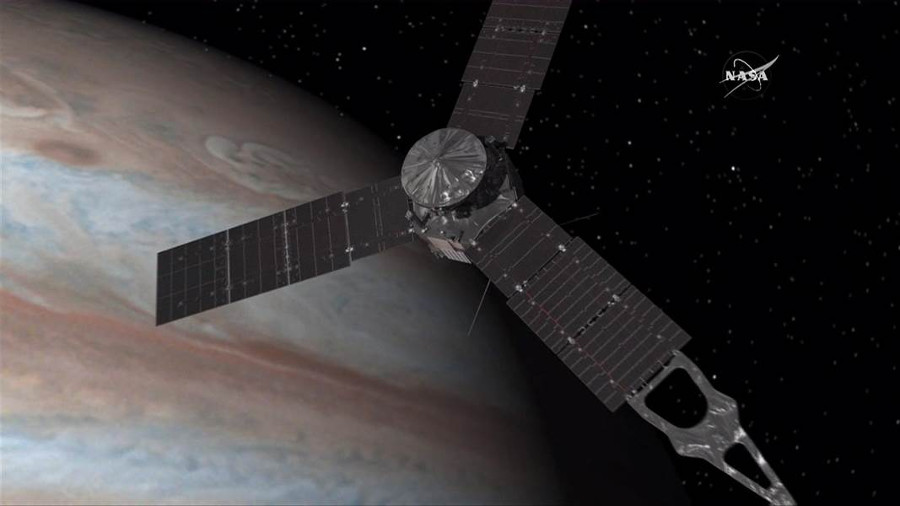NASA’s Juno spacecraft will soon fly over Jupiter’s Great Red Spot, marking it the first time a spacecraft will be so close to the 10,000-mile-wide (16,000 kilometers) storm. Juno is scheduled to pass over the storm on Monday at 10 p.m. ET.
Jupiter’s Great Spot is home to the Great Red Spot, its most iconic storm, which experts estimate has existed for over 350 years and since 1830, it’s been under scientific monitoring.

While Juno will pass at around 5,600 miles (9,000 kilometers) above the massive storm, NASA expects some amazing pictures and data. All the data should arrive by the weekend.
Juno Mission will complete its sixth orbit around Jupiter focusing on Great Red Spot
Juno launched almost six years ago from Cape Canaveral, aboard one of the Atlas V 551 rockets. The spacecraft has orbited around space since August 2011, and it arrived at Jupiter last year, as planned. Scientists at NASA are eager to discover what lies inside the Great Red Spot, a mysterious storm that has captured their attention for years.
“Jupiter’s mysterious Great Red Spot is probably the best-known feature of Jupiter,” said Scott Bolton, principal investigator of Juno from the Southwest Research Institute in San Antonio, according to NASA. “This monumental storm has raged on the solar system’s biggest planet for centuries.”
Bolton noted that now, the spacecraft and her “cloud-penetrating” science instruments will dive in to see how deep the roots of the storm go, and help scientists understand how the Great Red Spot storm works and what makes it so unique.
This will be Juno’s sixth flyby over Jupiter’s mysterious cloud tops. The spacecraft takes 11 days to complete a revolution while the gas giant takes only 10 hours to spin around once, according to NASA. Engineers at NASA designed Juno’s trajectory so that it would pass over a different section of Jupiter during each orbit. When Juno completes the mission’s 33 scheduled orbits, the spacecraft will have covered Jupiter’s entire surface.

To ensure that the probe collects the best possible scientific data it has to get close to Jupiter. On each planned orbit, Juno has gotten within 3,100 miles (5,000 kilometers) of the gas giant’s cloud tops. According to NASA, while that distance might seem like a great distance, if Jupiter were as large as a basketball, the equivalent distance would be around 0.315 inches (0.8 centimeters).
There’s another reason for Juno’s close orbit: to avoid the planet’s radiation. Jupiter’s radiation is concentrated in a belt that loops around the planet’s equator, said NASA. The equator is filled with tiny particles (electrons and ions) that move around nearly at light speed. The radiation is so harmful in Jupiter that two of Juno’s instruments, the camera, and the Jovian infrared auroral mapper, are planned to last only until Orbit 8, while the microwave radiometer is scheduled to continue until Orbit 11.
JunoCam will snap pictures of the Great Red Spot’s roots
Juno will reach perijove on Monday at 9:55 p.m. EDT. Perijove refers to the point at which an orbit gets closest to Jupiter’s center. When Juno reaches the perijove, the spacecraft will be about 2,200 miles (3,500 kilometers) above Jupiter’s cloud tops.
NASA estimates that eleven minutes and 33 seconds later, the spacecraft will have moved another 24,713 miles (39,771 kilometers) and will be precisely above the cloud tops of Jupiter’s Great Red Spot. Fortunately, all eight of Juno’s instruments and its camera, JunoCam, will be available –and still functional- during the flyby above the Great Red Spot.
On July 4 at 10:30 p.m. EDT Juno logged exactly one year orbiting Jupiter. By that day, the spacecraft had covered about 71 million miles (114.5 million kilometers) in orbit around Jupiter.
“The success of science collection at Jupiter is a testament to the dedication, creativity and technical abilities of the NASA-Juno team,” said Rick Nybakken, project manager for Juno from NASA’s Jet Propulsion Laboratory in Pasadena. “Each new orbit brings us closer to the heart of Jupiter’s radiation belt, but so far the spacecraft has weathered the storm of electrons surrounding Jupiter better than we could have ever imagined.”
Expert thinks there might be a giant blob underneath the Red Spot
Juno will pass again over the Great Red Spot again, as the spacecraft orbits once every 53 days around Jupiter. NASA explained that each planned flyby of the Great Red Spot would focus on a different aspect of the mysterious storm.
Bolton noted that maybe there is something massive below the Red Spot that is contributing to its long existence.
“Maybe there’s a blob going around Jupiter that’s underneath the Red Spot, and we may be able to see that,” said Bolton, according to NPR.
Early science results from the Juno mission have portrayed Jupiter as a turbulent world with a complex interior structure, says NASA.
Source: NASA Mission Juno
